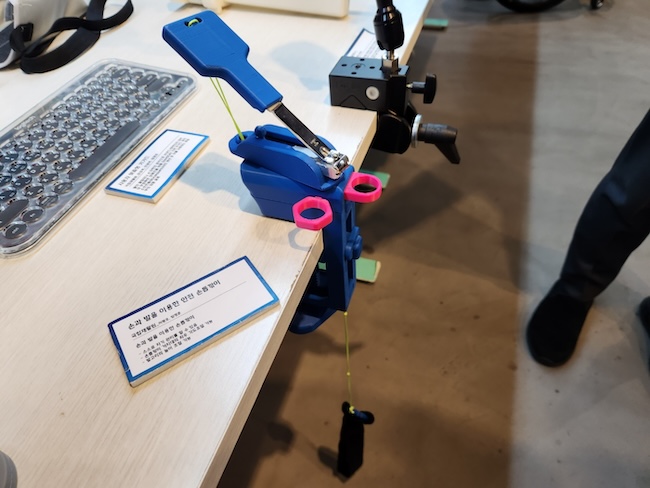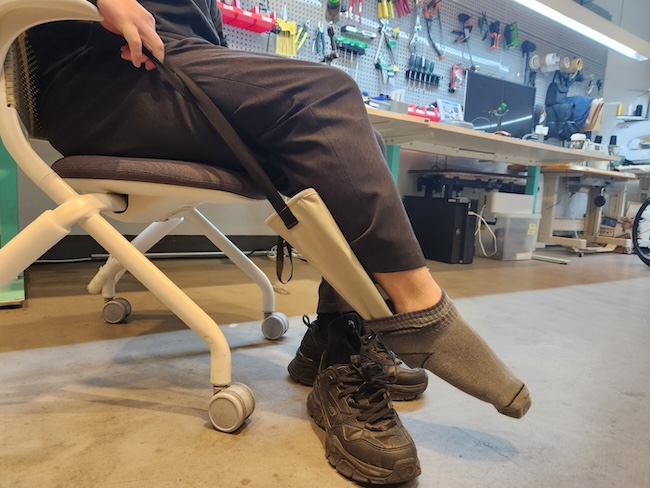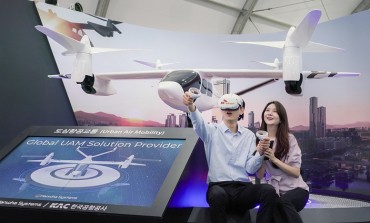
The ‘safety nail clipper for hand and foot use’ is particularly crafted for individuals who find it challenging to use standard nail clippers due to conditions like paralysis. (Image courtesy of Yonhap)
SEOUL, Dec. 21 (Korea Bizwire) – Innovations that transform seemingly mundane tasks into accessible achievements for individuals with disabilities have been developed at the National Rehabilitation Center’s ‘Open Fabrication Studio’ in Korea.
Among these innovations are a safety nail clipper that can be operated using hands and feet, and an assistive device for putting on socks – both designed to convert challenging tasks into routine activities for those with physical limitations.
The ‘safety nail clipper for hand and foot use’ is particularly crafted for individuals who find it challenging to use standard nail clippers due to conditions like paralysis.
This device is firmly attached to a desk, allowing users to operate it by stepping on a loop attached to its bottom, instead of using finger strength.
For people who cannot bend to put on socks due to conditions like ankylosing spondylitis, the ‘sock donning assistive device’ comes as a relief. It resembles a funnel into which a sock is fitted, and by pulling a handle, the user can easily slide their foot into the sock.
Another notable innovation is a rear-view camera for electric wheelchairs, developed in response to the difficulty faced by many in turning around. This device helps prevent accidents such as collisions or falls when the wheelchair is moving backward.

For people who cannot bend to put on socks due to conditions like ankylosing spondylitis, the ‘sock donning assistive device’ comes as a relief. (Image courtesy of Yonhap)
These devices, not easily available in Korea or often requiring considerable expense, have been developed with direct input from people with disabilities. One disabled YouTuber, after using the nail clipper assistive device, shared a video demonstrating how they could trim their nails neatly without anyone’s help, stating, “It’s too good to keep to myself.”
Eun Seon-deok, the team leader of the Independent Living Support Technology Research Team at the National Rehabilitation Center, emphasized the importance of these developments: “What might seem trivial to some can be incredibly crucial for others.”
Since 2020, the Ministry of Health and Welfare has been supporting research and development, as well as the production of assistive devices for the elderly and disabled. Devices with significant economic value and potential for domestic production are identified as strategic items, with support extended to consortia of industry, academia, and research institutions for their development.
Upon completion, these products are expected to be listed for insurance benefits under the National Health Insurance Service, facilitating their commercialization.
The first phase of this initiative, set to conclude this year, has resulted in the production of 54 policy items and 11 strategic product research projects. These include a leisure activity electric wheelchair for use at beaches and swimming pools, and high-functioning artificial legs as alternatives to expensive imports.
The Ministry of Health and Welfare and the National Rehabilitation Center showcased these innovative devices at a presentation held at the Amanti Hotel in Seoul on October 20, marking a significant step forward in enhancing the quality of life for individuals with disabilities.
M. H. Lee (mhlee@koreabizwire.com)





